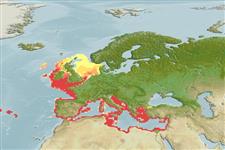Common names from other countries
Environment: milieu / climate zone / depth range / distribution range
Sinh thái học
; Mức độ sâu 25 - 200 m (Ref. 2754). Subtropical
Northeast Atlantic, Mediterranean and Black Sea.
Length at first maturity / Bộ gần gũi / Khối lượng (Trọng lượng) / Age
Maturity: Lm ? range ? - ? cm Max length : 4.8 cm SHL con đực/không giới tính; (Ref. 2758)
Depth based on occurrence (Ref. 2758, p. 805); to be replaced with better reference. Minimun depth from Ref. 2758. Main food and feeding type based on another species of the same Genus; to be replaced with a better reference (Ref. 95810).
Life cycle and mating behavior
Chín muồi sinh dục | Sự tái sinh sản | Đẻ trứng | Các trứng | Sự sinh sản | Ấu trùng
Members of the class Bivalvia are mostly gonochoric, some are protandric hermaphrodites. Life cycle: Embryos develop into free-swimming trocophore larvae, succeeded by the bivalve veliger, resembling a miniature clam.
Demir, M. 2003. (Ref. 2754)
IUCN Red List Status (Ref. 130435)
CITES status (Ref. 108899)
Not Evaluated
Not Evaluated
Human uses
| FishSource |
Các công cụ
Các nguồn internet
Estimates based on models
Preferred temperature
(Ref.
115969): 7 - 15.8, mean 10 (based on 403 cells).
Vulnerability
Low vulnerability (10 of 100).
